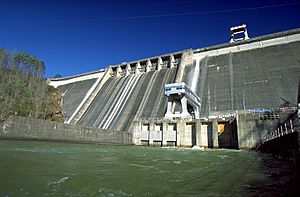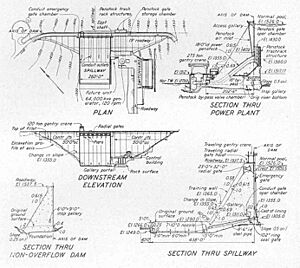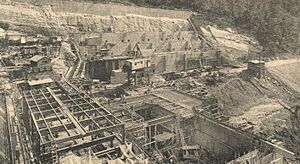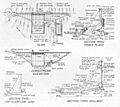Hiwassee Dam facts for kids
Quick facts for kids Hiwassee Dam |
|
|---|---|
 |
|
| Official name | Hiwassee Dam |
| Location | Cherokee County, North Carolina, United States |
| Coordinates | 35°9′5″N 84°10′39″W / 35.15139°N 84.17750°W |
| Construction began | July 15, 1936 |
| Opening date | February 8, 1940 |
| Operator(s) | Tennessee Valley Authority |
| Dam and spillways | |
| Impounds | Hiwassee River |
| Height | 307 ft (94 m) |
| Length | 1,376 ft (419 m) |
| Reservoir | |
| Creates | Hiwassee Reservoir |
| Total capacity | 434,000 acre⋅ft (535,000 dam3) |
| Catchment area | 968 sq mi (2,510 km2) |
| Power station | |
| Installed capacity | 185 MW |
The Hiwassee Dam is a huge structure on the Hiwassee River in Cherokee County, North Carolina. It's in the state of North Carolina, USA. This dam creates electricity from water power.
The Tennessee Valley Authority (TVA) built this dam in the late 1930s. Their main goals were to stop floods and provide electricity to the area. Hiwassee Dam is one of three dams TVA operates on this river.
The dam holds back water to form Hiwassee Lake. This lake covers about 6,000 acres (2,400 ha). At 307 feet (94 m) tall, Hiwassee Dam is the third highest dam in the entire TVA system. Only Fontana and Watauga dams are taller. In 2017, the dam was added to the National Register of Historic Places. This means it's an important historical site.
The dam is named after the Hiwassee River. The word "Hiwassee" comes from the Cherokee language. It means "savanna" or "large meadow."
Contents
Where is the Hiwassee Dam?
The Hiwassee River starts in Towns County, Georgia. It then flows northwest through Western North Carolina. The river cuts a beautiful valley through the southern Appalachian Mountains. It eventually reaches Chickamauga Lake in Tennessee.
Hiwassee Dam was built about 76 miles (122 km) from where the river ends. It sits at a large bend in the river called Fowler Bend. The dam is 10 miles (16 km) upstream from Apalachia Dam. It is also 45 miles (72 km) downstream from Chatuge Dam. The dam and its lake are surrounded by the Nantahala National Forest.
A small town called Hiwassee Village grew up near the dam and lake. It is just south of the dam. You can drive across the top of the dam on North Carolina State Highway 1314.
How Big is the Dam?
Hiwassee Dam is made of concrete. It is a "gravity-overflow" dam. This means its own weight holds it in place. It is 307 feet (94 m) high and 1,376 feet (419 m) long. The dam can produce 185,000 kilowatts of electricity.
The dam has seven gates to control water flow. It also has four special pipes at the bottom. These allow a lot of water to be released if needed.
Hiwassee Lake stretches for about 22 miles (35 km) upriver to the town of Murphy, North Carolina. The lake has 180 miles (290 km) of shoreline. It can hold 434,000 acre⋅ft (535,000 dam3) of water. About 205,590 acre⋅ft (253,590 dam3) of this is for flood control. The lake's water level usually changes by about 38 feet (12 m) each year.
Pumped Storage System
In the 1950s, TVA started trying out a new idea at Hiwassee Dam. It was called pumped storage. They used a special turbine that could also work as a pump. During times when not much electricity was needed, this pump would push water from below the dam back up into the lake.
This was the first time a pump and turbine were combined like this in the United States. At the time, it was also the biggest and most powerful in the world. Because of this amazing invention, the "pump-turbine" at Hiwassee is now a "National Historic Mechanical Engineering Landmark." This honor was given by the American Society of Mechanical Engineers (ASME).
Building the Hiwassee Dam
People knew the Hiwassee River could be used to make electricity since the early 1900s. Some smaller dams were already built by cities like Andrews and Murphy. In the 1920s, big power companies wanted to build larger dams. One company bought land in 1924 to build a dam, but their project never happened.
The Tennessee Valley Authority (TVA) was created in 1933. It was part of President Franklin D. Roosevelt's New Deal plan. TVA was put in charge of controlling floods in the Tennessee River area, which included the Hiwassee River. They also wanted to build power plants to bring electricity to rural areas.
One of TVA's first big goals was to stop floods on the Hiwassee River. Its waters often caused floods in Chattanooga. In 1935, the US Congress approved building Hiwassee Dam. Work started the next year, in 1936. The power company that owned land there sold it to TVA. They had a disagreement about the land's price for a while, but TVA finally paid $250,000 in 1944.
Building the dam and lake needed a lot of land. TVA bought 24,102 acres (9,754 ha) of land. They had to clear 3,836 acres (1,552 ha) of it. This meant moving 261 families and 462 graves. About 25 miles (40 km) of roads also had to be moved. Eight new bridges were built, and a railroad bridge needed changes. The city of Murphy's riverfront also needed protection.
Hiwassee Dam is very tall, so it needed a huge amount of concrete. Engineers worried that the concrete would get too hot as it dried. This could cause cracks. To prevent this, the dam was built in sections, like giant blocks. Each block was no more than 50 feet (15 m) long. Special pipes were put in the blocks to help heat escape. They also used a special type of cement that didn't get as hot.
The dam's gates were closed on February 8, 1940. Some smaller construction work continued until later that year. The first generator started making electricity on May 21, 1940. The whole project cost over $24 million. After the dam was finished, TVA gave 17,000 acres (6,900 ha) of its land to the U.S. Forest Service. This land became part of the Nantahala National Forest.
In 1952, a second generator was added. This was the special pump-turbine unit built by Allis-Chalmers Company. Its electrical system broke down in 2011. It was fixed and started working again in 2016.
Images for kids






